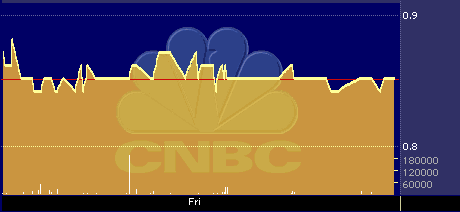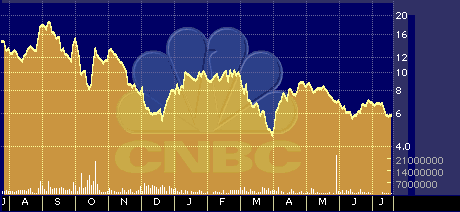
Neoforma.com Shares Soar in Debut
Neoforma.com Shares Soar in Debut
by Hal Plotkin
Silicon Valley Correspondent
Want to buy into the red-hot business-to-business market and hedge your bets with the health-care sector? If today’s IPO of Neoforma.com {NEOF} is any indication, other people may have the same idea.
Neoforma’s initial public offering made a big splash, opening at $36.50, after the company priced its 7 million shares at $13 apiece, above an expected range of $10 to $12. It closed at $52.38, surviving a broad selloff in tech stocks.

Neoforma.com Post-IPO Stock-Performance Chart
Analysts for the most part have expressed enthusiasm for the company’s approach to the business-to-business health-care sector.
“I think there are a lot opportunities for companies to create value by efficiently combining buyers with suppliers to eliminate inefficiencies,” says Brian Kearns, an analyst with Banc of America Securities, based in New York.
In addition, rumors continue that Neoforma.com will soon make a material announcement concerning its marketing partnership with Santa Clara, Calif.-based Healtheon/WebMD Corp. {HLTH} that could pump up interest in the stock even further.

Healtheon/WebMD Post-IPO Stock-Performance Chart
Analysts give Neoforma.com, which is also based in Santa Clara, Calif., high marks for making progress in a notoriously difficult market.
Kearns, for example, says building an online health-care equipment marketplace of the sort envisioned by Neoforma.com is a difficult task that involves a classic chicken-and-egg problem. If a site has too few suppliers, it won’t attract buyers in sufficient numbers. And without the buyers, suppliers have less reason to sign up.
“It’s a race to see who can gather the most participants first,” Kearns says. “In that sense, Neoforma has an advantage because they got an early start.”
Peter Boland, an industry analyst and founder of Boland Healthcare, based in Berkeley, Calif., says he is impressed with Neoforma’s approach.
“The company is well-positioned to take advantage of a burgeoning new market opportunity powered by the ease and compelling logic of online purchasing,” Boland says.
The positive sentiment is shared by Eric Brown, who leads the health-care research team at Forrester Research, based in Cambridge, Mass. “What Neoforma.com is doing is interesting and exciting,” he says. “It really gets the Internet juices flowing.”
Brown adds that he likes the fact that health-care equipment buyers can use Neoforma’s services with a desktop browser, rather than having to install an entirely new procurement management system.
Neoforma is working on creating a kind of eBay Inc. {EBAY} for the health-care industry. The firm envisions itself as a full-service provider of medical equipment and facility-design services. One of the key components of Neoforma’s strategy involves the hosting of auctions where surplus high-price medical equipment and supplies can be sold or exchanged among health-care organizations.
Last May, the company inked a marketing arrangement with Healtheon/Web MD to jointly promote Neoforma’s novel method of selling new and used medical equipment.
The annual overall market for medical supplies in the U.S. is estimated at $140 billion, according to a recent Internet/eHealth report published by Goldman Sachs Investment Research, based in New York.
At present, Neoforma has captured only an infinitesimal slice of that market. The company’s Web site currently lists just 14 suppliers and four medical institutions that have formally signed up to use the service. Analysts say that performance in the B2B health-care space is, however, better than the track record of many other online companies going after the same market, all of whom seem to be encountering considerable resistance.
Richard Lee, an analyst at Wit Capital based in San Francisco, says investors should be aware that institutional health-care buyers are often restrained from buying equipment or services over the Web at the most competitive prices. “Trying to disintermediate the distributors is a pipe dream,” he says. “There’s been a lot of push-back on the B2B side. Companies are not making a huge amount of inroads.”
Lee says he is more optimistic about one of Neoforma.com’s competitors, privately held Medibuy.com Inc., which is based in San Diego. The company is an early champion of what Lee thinks will be a winning business model.
“The best approach is to try to get the existing distributors [of health-care products and services] on their sites as a way to drive incremental sales,” Lee says, adding that such an approach is the centerpiece of Medibuy.com’s strategy.
Chemdex Corp. {CMDX}, based in Mountain View, Calif., is another major competitor in the hard-to-penetrate market.
One problem facing Neoforma.com and similar companies, analysts say, is the fact that the health-care industry has thus far largely resisted the attempts of Internet firms seeking to streamline notoriously bloated and inefficient medical procurement, billing and record-keeping procedures. It’s a system that recent studies say has at least $11 billion worth of waste in the supply chain each year, according to Darren Marhula, an analyst at U.S. Bancorp Piper Jaffray, based in Minneapolis.
Eliminating that waste, however, is no walk in the park.
Legacy systems, traditional industry practices, the dominance of a handful of major medical equipment distributors, and pre-existing hospital and medical-center group-purchasing arrangements are holding the health-care sector back from the type of Internet-fostered changes to business models that are rapidly taking hold in many other parts of the economy.
“The industry’s electronic data interchange infrastructure is hanging like a millstone around the necks of many health-care institutions,” Brown says.
“I think the B2B side is going to be very, very tricky,” adds Dr. Wally Buch, a physician and general partner at Atherton Ventures, an investment group based in Menlo Park, Calif.. “It will be very hard to disintermediate the hospitals,” he says. “They’re notoriously conservative and reluctant to get rid of the group-purchasing organizations. It’s going to be quite a task.”
But Boland, says he thinks the time is nearing when Neoforma can enjoy considerable success in its target markets. “Neoforma is in the right place at the right time in terms of the cost pressures, customer interface and the technology curve,” he says.
Neoforma.com posted a loss of $8.1 million on revenue of just $7,000 for the six months ended June 30, 1999, compared with a loss of $1.1 million on zero revenue for the same period a year earlier.


